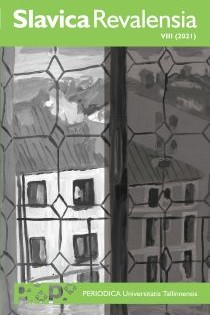Keywords
19th-Century Russian Literature
Alexander Pushkin (1799—1837)
Buria (1825)
Russian Iambic Tetrameter
Semantics of Rhythm
Verse Theory
Alexander Pushkin (1799—1837)
Buria (1825)
Russian Iambic Tetrameter
Semantics of Rhythm
Verse Theory
How to Cite
Dotsenko, S. . (2021). Ритм и смысл стихотворения Пушкина «Буря» [Pushkin’s “Buria”: The Meaning of Rhythm]. Slavica Revalensia, 8, 48-55. https://doi.org/10.22601/SR.2021.08.02
Abstract
This article addresses the meaning of the verse form of Alexander Pushkin’s poem “Buria” (1825). The poem’s monotonous rhythm corresponds to the theme of waves hitting the seashore and the rock in the same monotonous manner. The rhythmic structure of the poem implies that it can be divided into four three-line sections, each of which alternates between two rhythmic forms of iambic tetrameter (IV—IV—I, IV—IV—I, etc.). The stanzaic structure of the poem, which is a monostrophe, helps one to sense that pattern.

This work is licensed under a Creative Commons Attribution-ShareAlike 4.0 International License.
Copyright (c) 2021 Slavica Revalensia
Similar Articles
- Lev Sobolev, Два письма П. А. Вяземского [Two Letters by Pyotr Vyazemsky] , Slavica Revalensia: Vol. 7 (2020): Slavica Revalensia
- Alexander Dolinin, On Some Contexts and Subtexts of Nabokov’s Podvig , Slavica Revalensia: Vol. 7 (2020): Slavica Revalensia
- Andrei Ustinov, Ancora da capo: Об «Элегии» Александра Введенского [Ancora da capo: On Alexander Vvedensky’s “Elegy”] , Slavica Revalensia: Vol. 11 (2024): Slavica Revalensia
- Anna Gubergits, Иллюстрация в детских журналах царской России [Pictures in Children’s Literature Journals of Czarist Russia] , Slavica Revalensia: Vol. 2 (2015): Slavica Revalensia
- Kirill Zubkov, Наука о литературеи литературная классика: Опыт критического обзораюбилейной гончаровской литературы [Literary criticism and the literary canon: A survey of the literature devoted to Ivan Goncharov´s bicentennial (2012)] , Slavica Revalensia: Vol. 1 (2014): Slavica Revalensia
- Lev Sobolev, Одно письмо П. А. Вяземского [One Letter by Pyotr Vyazemsky] , Slavica Revalensia: Vol. 6 (2019): Slavica Revalensia
- Alexander Dolinin, Grigori Utgof, Неизвестная рецензия Набокова [An Unknown Review by Nabokov] , Slavica Revalensia: Vol. 5 (2018): Slavica Revalensia
- Valerii Otiakovskii, Подводная археология. Рец. на кн.: _Бабак Г., Дмитриев А._ Атлантида советского нацмодернизма: Формальный метод в Украине (1920-е – начало 1930-х). М.: Новое литературное обозрение, 2021. 784 с. [Underwater Archaeology. Review of _Atlantida sovetskogo natsmodernizma: Formal’nyi metod v Ukraine (1920-e — nachalo 1930-kh)_, by Galina Babak and Alexander Dmitriev] , Slavica Revalensia: Vol. 9 (2022): Slavica Revalensia
- Pavel Uspensky, Некрасов и Боратынский: Вокруг рецензии на «Дамский альбом», новых взглядов на брак и двух любовных стихотворений [Nekrasov and Baratynsky: Notes on Nekrasov’s Review of the “Damskii albom” Anthology, New Vision on Marriage and Two Love Poems] , Slavica Revalensia: Vol. 3 (2016): Slavica Revalensia
- Olga Makarevich, «Новая назидательная книга»: Неизвестный отзыв Н. С. Лескова на перевод “The Pilgrim’s Progress” Дж. Баньяна [“A New Didactic Book”: An Unknown Nikolai Leskov’s Review of a Russian Translation of “The Pilgrim’s Progress” by John Bunyan] , Slavica Revalensia: Vol. 5 (2018): Slavica Revalensia
You may also start an advanced similarity search for this article.
Most read articles by the same author(s)
- Sergei Dotsenko, Кто такой «музыкант Набоков»? (Из комментария к книге А. Ремизова «Учитель музыки») [Who is “the Musician Nabokov”? Rereading Aleksey Remizov’s _The Music Teacher_] , Slavica Revalensia: Vol. 9 (2022): Slavica Revalensia
- Sergei Dotsenko, Об источниках сказки А. М. Ремизова «Султанский финик» [A Likely Source of Remizov´s Fairy Tale “Sultanskii finik”] , Slavica Revalensia: Vol. 3 (2016): Slavica Revalensia
- Sergei Dotsenko, О строфической структуре верлибра А. А. Блока «Она пришла с мороза…» [On the Strophic Pattern of Alexander Blok’s Free Verse Poem “Ona prishla s moroza…”] , Slavica Revalensia: Vol. 1 (2014): Slavica Revalensia
- Sergei Dotsenko, Знакомая незнакомка: Рец. на кн.: «Заре Григорьевне Минц посвящается…: Публикации, воспоминания, статьи. К 90-летию со дня рождения» [A Known Unknown: “Zare Grigor’evne Mints posviashchaetsia. Publikatsii, vospominaniia, stat’i. K 90-letiiu so dnia rozhdeniia.” A review article] , Slavica Revalensia: Vol. 5 (2018): Slavica Revalensia
- Sergei Dotsenko, Образ Петра I в повести А. Ремизова «Крестовые сестры» [The Image of Peter the Great in Alexei Remizov’s Short Novel “The Sisters of the Cross”] , Slavica Revalensia: Vol. 4 (2017): Slavica Revalensia
